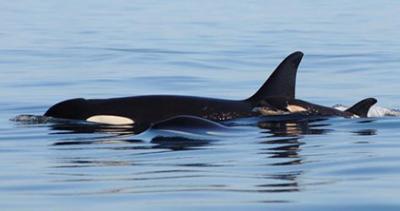
Fading in the Kelp

Our endangered Resident orcas brought a glorious October Surprise to Vashon when about 60 of them graced us with a visit on October 17. They traveled south to Point Robinson in the morning and then, as is typical in early fall, they did the East Passage shuffle and turned north again by afternoon.
That was my lead until I got confirmation of the dismal news I feared -- another blow to Southern Resident orca recovery. Much of L Pod had been out to sea for a week or so. The grim clues started to emerge when the orcas visited Puget Sound.
On the 17th, VHP associates Mark and Maya Sears deployed in the NOAA research boat with Brad Hanson (see “Orca Chow” in the 10/9/14 edition of The Loop). The killer whales had dispersed widely by the time the researchers caught up with them, so they did focal follows with small groups and individual orcas in an effort to collect samples.
Curiously, they saw no foraging behavior and found no evidence, either; i.e., no fish scales or prey remnants. Poop scooped was miniscule. Members of J, K and L Pods meandered and socialized – spyhopping, breaching, slapping pectoral flippers and tail flukes. Mark commented that, as they headed north, the whales were extraordinarily scattered across the Sound, from Bainbridge Island to inside Elliott Bay. Two miles separated the leading groups from the trailing groups, a continuation of a pattern we observed this summer in Haro Strait.
The researchers did not see L120 on October 17, nor did the baby appear in any of the copious photos posted online. In the days following the Puget Sound encounter, experienced observers in the San Juans spotted L120’s close relatives – mom Surprise! (L86), aunt Ophelia (L27), and brother Pooka (L106) – but no baby. At barely seven weeks old, Baby L120 is a dearly departed one.
Knowing that mortality is about 40-50% for a Southern Resident newborn in the first year does not alleviate the sting of this death. Ti’lem I’nges (J49), age 2, is still the youngest community member. Inexplicably, 25 months elapsed between his birth and L120’s. Reproductive collapse is another alarming indicator that these killer whales are inordinately stressed.|
This article is a somber bookend to one I wrote for the 9/11/14 issue of The Loop called “A Moment’s Sunlight.” With the soul-crushing loss of Baby L120, L Pod falters at 34 and the Southern Resident population drops to an anemic 78. Something dreadful is afoot in L Pod, and we are failing to discern what it is.
Indisputably, J, K, and L Pods are struggling to find enough Chinook salmon to eat. I wrote about this last time. Other major threats plaguing the Southern Residents include deadly toxins in their blubber; disturbance from ever-increasing underwater noise and crowding by boats; military sonar; disease; oil spills; and climate change.
Our orcas are on borrowed time. Without bold recovery efforts, they will be extinct in 100 years. Addressing the complex threats facing Southern Residents from depleted prey resources and persistent bioaccumulative toxins are long-term recovery goals. We can help our orcas now by reducing boat pressure on them, and by living more consciously, selflessly, and sustainably in their habitat.
Please support the work of the Vashon Hydrophone Project (VHP): REPORT LOCAL WHALE SIGHTINGS ASAP TO 463-9041, as well as seal pups and sick, injured, or dead marine mammals on Island beaches. Prompt reports to the VHP expedite vital data collection efforts and sustain an accurate record of whale sightings for Vashon-Maury initiated three decades ago by Mark Sears. Send photos to Orca Annie at Vashonorcas@aol.com and check for updates at Vashonorcas.org.
- Login to post comments
